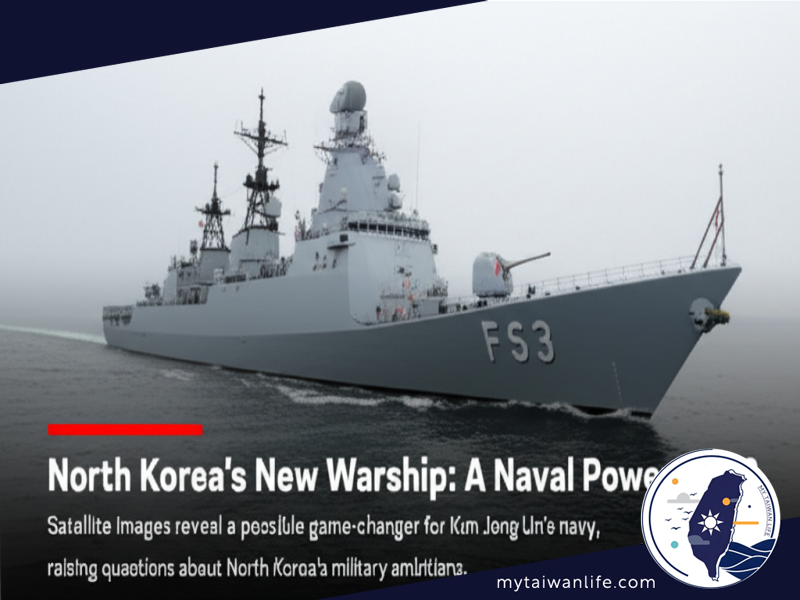North Korea's New Warship: A Naval Power Play?
Satellite images reveal a possible game-changer for Kim Jong Un's navy, raising questions about North Korea's military ambitions.

New satellite images have unveiled what appears to be North Korea's largest warship ever, sparking significant interest and concern within the international community. The vessel, currently under construction at the Nampo shipyard, west of Pyongyang, is potentially more than double the size of any existing ship in Kim Jong Un's naval fleet.
Satellite images from Maxar Technologies and Planet Labs, taken on April 6, depict the ongoing construction of the ship. Analysts suggest it's likely a guided-missile frigate (FFG) designed to carry missiles in vertical launch tubes, capable of targeting both land and sea. According to Joseph Bermudez Jr. and Jennifer Jun at the Center for Strategic and International Studies, the FFG is approximately 140 meters (459 feet) long, making it the largest warship manufactured in North Korea.
The rapid modernization of North Korea's armed forces, including the development of new weapons and ballistic missile tests, has been a continuous process. The nation has been operating under UN sanctions that restrict its access to the materials and technology necessary for weapon development. However, analysts are speculating that closer ties with Russia since the Ukraine war might be helping North Korea bypass these sanctions.
Retired South Korean admiral Kim Duk-ki suggests Moscow might be providing technology for the frigate's missile systems. Images of the vessel previously appeared in a report by state-run Korean Central Television, showcasing Kim inspecting the ship's construction. The vessel appears to include modern weaponry, including vertical launch cells and phased-array radar.
However, analysts caution against drawing definitive conclusions. Carl Schuster, a former US Navy captain and Hawaii-based analyst, emphasizes the complexity of modern warship construction. Kim Byung-kee, a South Korean lawmaker, raises concerns about Pyongyang's technical capabilities and the costs associated with operating such a large warship.
Kim Duk-ki warns that if North Korea equips the new frigate with hypersonic ballistic missiles, it could drastically impact regional security. Schuster believes that at least another year of work is required before sea trials can begin.
The North Korean navy currently has approximately 400 patrol combatants and 70 submarines. However, most are old and small. Joseph Dempsey, an analyst at the International Institute for Strategic Studies, notes that North Korea possesses only two principal surface combatants. The current focus by Kim Jong Un is modernizing the naval fleet, including the development of submarine-launched missiles and the construction of a new naval port. Furthermore, reports suggest that a nuclear-powered submarine and another frigate or destroyer are also under development.
Other Versions
El nuevo buque de guerra de Corea del Norte: ¿Un juego de poder naval?
Le nouveau navire de guerre de la Corée du Nord : Un jeu de puissance navale ?
Kapal Perang Baru Korea Utara: Sebuah Permainan Kekuatan Angkatan Laut?
La nuova nave da guerra della Corea del Nord: Un gioco di potere navale?
北朝鮮の新しい軍艦:海軍のパワープレー?
북한의 새로운 군함: 해군의 힘겨루기?
Bagong Barkong Pandigma ng Hilagang Korea: Isang Paglalaro ng Lakas sa Dagat?
Новый военный корабль Северной Кореи: Военно-морская игра?
เรือรบลำใหม่ของเกาหลีเหนือ: การแสดงแสนยานุภาพทางเรือ?
Tàu chiến mới của Triều Tiên: Một nước đi của Hải quân?
Categories
Warning: Undefined array key "article_category" in /web/htdocs/www.mytaiwanlife.com/home/news/sidebar.php on line 126
Deprecated: html_entity_decode(): Passing null to parameter #1 ($string) of type string is deprecated in /web/htdocs/www.mytaiwanlife.com/home/news/sidebar.php on line 126
Warning: Undefined array key "article_category" in /web/htdocs/www.mytaiwanlife.com/home/news/sidebar.php on line 126
Deprecated: html_entity_decode(): Passing null to parameter #1 ($string) of type string is deprecated in /web/htdocs/www.mytaiwanlife.com/home/news/sidebar.php on line 126
Warning: Undefined array key "article_category" in /web/htdocs/www.mytaiwanlife.com/home/news/sidebar.php on line 126
Deprecated: html_entity_decode(): Passing null to parameter #1 ($string) of type string is deprecated in /web/htdocs/www.mytaiwanlife.com/home/news/sidebar.php on line 126
Warning: Undefined array key "article_category" in /web/htdocs/www.mytaiwanlife.com/home/news/sidebar.php on line 126
Deprecated: html_entity_decode(): Passing null to parameter #1 ($string) of type string is deprecated in /web/htdocs/www.mytaiwanlife.com/home/news/sidebar.php on line 126
Warning: Undefined array key "article_category" in /web/htdocs/www.mytaiwanlife.com/home/news/sidebar.php on line 126
Deprecated: html_entity_decode(): Passing null to parameter #1 ($string) of type string is deprecated in /web/htdocs/www.mytaiwanlife.com/home/news/sidebar.php on line 126
Warning: Undefined array key "article_category" in /web/htdocs/www.mytaiwanlife.com/home/news/sidebar.php on line 126
Deprecated: html_entity_decode(): Passing null to parameter #1 ($string) of type string is deprecated in /web/htdocs/www.mytaiwanlife.com/home/news/sidebar.php on line 126

